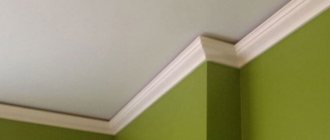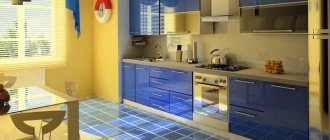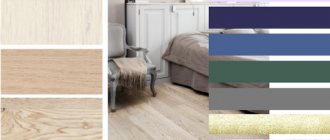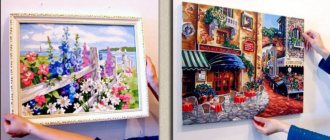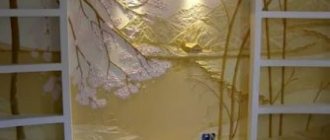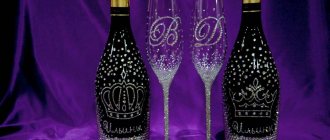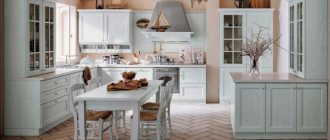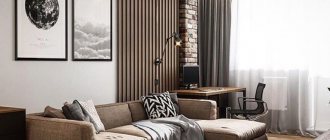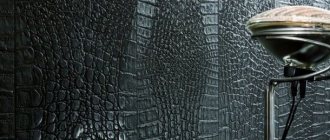Decor plays an important role in interior design. It has a great influence on style and emphasizes the dignity and character of the room. Taking into account the style decision, accessories should be selected, thought out to the smallest detail. The most popular items for wall decoration include paintings. Now everyone has the opportunity to choose an image to their taste, be it a graphic drawing, photo or classic oil painting. To give the canvas a finished look, picture frames are often used. Fortunately, it is possible to buy a ready-made version in a store, choosing its appearance, size, material yourself, or even making it yourself.
There are many types of picture frames to suit every taste. For connoisseurs of a laconic interior, you can decorate the image with a simple baguette without unnecessary decor. The classic style involves decorating walls with paintings with massive carved frames made of wood. A high-tech kitchen does not accept unnecessary decor, but it may well allow you to place a couple of posters or photos in a metal frame on the wall.
Baguette for wooden paintings
Natural wood is the most popular and traditional material for making frames of various thicknesses, shapes, with or without decoration. Wood has a number of advantages, among which the most significant are: attractive appearance, even in an untreated state, strength, durability and environmental safety.
A wooden frame for a picture can be bought in a store, made to order in a workshop, or made with your own hands using photos and instructions found on the Internet or magazines. This natural material is ideal for hand-made paintings, tapestry, embroidery, watercolor or pastel drawings.
Wooden baguette
Wood is the most common type of material for baguettes. Creating such a frame is a rather complex creative process, and a carved baguette can be called a work of art.
One of the advantages of a wooden baguette is durability. The natural material itself implies quality, and paint and varnish coatings protect it from external factors. It will last for many years while maintaining its excellent appearance.
Another advantage of a wooden baguette is its texture. You can create both embossed and smooth products from this material. In addition, by painting them with special paint, you can decorate the baguettes in different styles - to look like stone, metal, or artificially age the frame.
The environmental friendliness of wood should be highlighted. This means that the product is safe for people, as it does not contain harmful impurities. The wood also smells pleasant, creating a special atmosphere in the room.
Making a wooden baguette
To create wooden baguettes, the best wood without flaws and knots is used. The material is completely dried, making it lighter and denser. If the wood is not completely dried, you can get a low-quality product - the material will dry out in the finished baguette, which may cause cracks to appear in it.
To get a quality baguette, it is better to buy it from a trusted place. This way you will be insured against disappointments in the future.
Products made from plastic
A good alternative to a wooden frame can be a plastic picture frame. Unlike wood, it is lighter in weight, and its cost is significantly lower than the previous option. If the painting is not of particular material value, is not a work of art or an antique, then plastic is quite suitable for framing a painting canvas, photo or poster.
Plastic frames, like wooden ones, can have carved decor, various shapes and sizes. If desired, you can order their production in a variety of shades, in accordance with the interior design. Such options are easy to buy in a store, made to order in a framing workshop, or made with your own hands.
History of frame moldings
The word “baguette” came to us from France (French baguette, lit. stick) and means: “a carved or painted plank for making frames or decorating walls.” Traditionally, baguettes and picture frames were made of wood, but frames from silver, bronze and other metals. Over the centuries, the fashion and style of picture frames have changed, as have artistic movements and interior design trends. But one thing has remained constant - the connection between the frame and the painting; a well-chosen frame emphasizes the individuality of the painting and puts the painting, not the frame, in the foreground.
The use of baguette began in Antiquity. Archaeologists found the first frames in Egyptian tombs, which date back more than 2 thousand years BC. Archaeologists found a Fayum portrait framed in a wooden frame. This indicates that the portrait, together with its frame, hung in the home before burial. However, the frame of those times is more correctly called a border or border to separate the interior and portrait.
Baguette for interior design
Initially, the baguette was used to hide gaps between the decorations and the surface. Carved baguette was used to decorate palaces, rich houses, and villas. Craftsmen used moldings to decorate walls and ceilings, for example, mosaics and fresco paintings. When selecting a molding to decorate interiors, craftsmen sought to ensure that it would be in harmony with the windows and doors.
In the Middle Ages, baguette was most often used in the design of temples and churches; in addition, baguette was used to decorate the pages of manuscripts.
Baguette for pictures
The most ancient molding was used as a border or border between wall paintings, paintings, pottery and building architecture. Egyptian and Greek artists used a baguette or border to divide their wall paintings into small sections. In those days, drawings and paintings were made on painted panels, in which the frame and the work itself were made and carved from one piece of wood.
Although difficult to produce, a frame or border was cut to protect the item and add depth. Over time, a more efficient production method was invented, in which the baguette is produced in meter-long pieces of wood. These pieces of wood were later attached to a wood panel and created the same effect as a frame. The pieces of wood for the frame were held together with glue and nails. An example of such a frame can be seen in the picture.
Architectural frames
The first independent frame (separated from the icon and the painting) was created by the artist Gentile De Fabiano in 1423, into which the main painted panel of the altar “Adoration of the Magi” was inserted. This frame belongs to the Gothic style and is associated with Venetian taste. A more recent example of such a temple or architectural frame is the Annunciation of Cortona by the artist Fra Angelico. These frames and works inspired craftsmen to create frames for private collections of icons.
Cassette frames
The design of altar frames evolved along with changes in architecture. In the 15th and 16th centuries, portraiture began to develop, which went beyond religious themes and led to the development of the frame. A cassette frame (“small box”) began to be used to frame portraits.
The cassette frame included an extended and identical profile on all four sides of the painting. The structure of such frames arose from the simplification of temple frames, which made them more accessible. In the 16th-17th centuries, the profiles and moldings of such frames developed regional trends and motifs, which led to the emergence of certain regional styles (Tuscan, Venetian, Bolognese and Neapolitan). Such frames were joined with an overlap (90 degrees).
Gallery frame
As previously written, the main difference between a temple frame and a cassette frame is that a cassette frame has the same profile on all four sides. However, there is another type of frame - a gallery frame, which blurs the concepts of these two types of frames. Like the cassette frame, the gallery frame serves as decoration for the painting. Gallery frames could be symmetrical, but the lack of structural parts classifies them as architectural frames. Or gallery frames could be symmetrical horizontally and vertically, have a cassette frame design and the only difference would be in the profile and baguette of the frame.
The most successful gallery frames can be called Sansovino frames (carved frame). Their name comes from the Florentine sculptor and architect Jacopo Sansovino, who lived in Venice from 1527 until his death in 1570. The main distinguishing feature of his frames were repeating and intertwining curls, very often roughened, sometimes with the addition of animal and human subjects. These frames were used during the Renaissance, when the paintings of great artists needed a beautiful, dignified design. Baguette decoration has become a separate art. Craftsmen developed techniques for making picture frames. The baguette becomes refined and rich. Often, artists of that time themselves came up with sketches of a baguette and took on its execution. This type of frame lasted for most of the 17th century and became emblematic of the Venetian frame style. Later, more simplified versions of these frames began to be made.
Materials for frames in the Renaissance
The Renaissance workshop was very meticulous about different types of wood when used in frame ornaments. Inexpensive wood (poplar, spruce and pine) was left for secondary frame parts. Because of its smooth structure, poplar was used to create simple frame profiles. Basswood, which is similar to poplar but has a smoother and more compact structure, was more suitable for more complex carved frames. All these types of wood were used to make frames, which later went through a gilding process. Walnut wood is more expensive, so it was used for frames that were not gilded or partially gilded (luminolegno). The rich color of walnut was highly valued by craftsmen; this color was often imitated using other types of wood. In the mid-16th century, ebony was used for the profiles of expensive baguettes, which were decorated with semi-precious stones. Oak was rarely found in Italian frames.
Conceptual frames
During the Renaissance, artists' paintings and icons received not only "material frames" but also "conceptual" frames. Therefore, picture frames, reminiscent of a “window in the wall,” were the first to see daylight. Later, in Kant's time, this would be introduced into academic art theory and reinforced by a system of opinions about paintings associated with craft, antiquity. This meant that the artist’s work was “framed” not only by a material frame, but also by written and spoken declarations and meanings, such as exhibition catalogues, books, author’s notes. With some simplification, we can say that the frame for a visual image is a meeting between the author of the picture and the gaze of the viewer, as a result of which an artistic image is born. Due to the fact that the painting is perceived differently at different times, it is an object of historically variable importance.
Baguette for metal paintings
A modern technological option is the use of metal elements in interior decoration. This also affected the design of images. You must understand that an aluminum frame is not appropriate for classical oil or pastel painting, but a poster, poster or photo can be designed in a similar way.
Most often, metal frames are used in offices or exhibition halls for various types of advertisements, posters, and presentation materials. But for techno lovers, this option is also appropriate in the interior of an apartment.
Types of baguettes
Picture frames are available for sale in several profile options. You can choose the one you need based on your interior style, taste preferences, as well as the type of image you plan to design.
- Classic profile look. This baguette creates a visual effect of “internal” volume. The shape of the frame has differences in height: at the edge it is thicker, and at the canvas it is thinner. Thus, the viewer's gaze is concentrated on the image, as if he were looking through a window.
- Reverse profile view. In this case, on the contrary, differences in thickness occur from the inner edge of the frame to the outer, thereby creating the effect of “pushing out” the image. In such a baguette you can decorate not only paintings on canvas, but also mirrors.
- Flat profile view. The frame has virtually no differences in thickness and no pronounced surface relief. Unlike the previous two options, the flat profile does not take much attention, but allows the viewer to enjoy the image. A simple painting baguette can be used to decorate paintings in a modern style, abstraction and other works in bright, contrasting shades.
Combining profiles of different shapes and types, both wooden and plastic, is also welcome; for example, you can combine a flat wide frame with a classic one.
Some paintings can be additionally decorated with edging - a thin strip with or without a carved pattern. This will give an additional effect to the image.
What materials is the baguette made from?
A baguette is primarily made from wood or on a wooden base. Wood is one of the most familiar and pleasant materials for human beings. And for paintings, wooden baguette is the most desirable natural material, in which the images will have a natural look. Only a wooden baguette allows you to make a frame from it that will delight and exude positivity for many years. When it is possible not to talk about the beauty of a baguette frame, but simply to show images in frames made of wooden baguette, which was selected, and not “selected by color,” it is better to show. But, unfortunately, it is even possible to convey female beauty in a photograph, but it is simply impossible to convey true beauty, the simply unimaginably stunning beauty of some designs. They can only be appreciated live, seen and touched. And only then will you understand how beautiful a wooden frame is. We are not talking about a mass-produced baguette here.
In the time of our ancestors, there was no plastic. The history of the baguette and the material from which frames have long been made, of course, were wooden. Notable people of that time ordered paintings, paying great attention to their framing. Wood carvers made each frame as a separate work of art. This was complex, painstaking, creative work. The artist himself, from whom the painting was ordered, was always in contact with the carver, so that the baguette would be in harmony and correspond to the creative solution.
If we assume for a moment that a painting in a plastic frame was brought to the court of a noble nobleman, I can imagine the degree of his disappointment, as instead of the generally accepted, heavy, weighty and good-quality wooden frame, the nobleman hung a plastic trinket on the wall, which he clearly cannot pass on to his children and grandchildren by inheritance, it would simply fall apart.
Wood products have always been in price. And it is not surprising that antique frames are now so expensive at auctions. After all, even without paintings, they themselves are a work of art by the old framers.
In the modern world, unfortunately, plastic has crept even into the field of framing. They are also trying to make a baguette out of it, which is “very similar to wood.” In the useless debate “wooden baguette or plastic”, a person’s inner feeling always interferes when looking at warm wood and the absolutely dead material “plastic baguette”. Some people are convinced that they like a “plastic baguette,” but these are only those who cannot pay for and see with their own eyes a wooden baguette in place of plastic, which can only match the color of the picture. But it will remain lifeless and will never play around the picture like a wooden one.
You can draw an analogy with children's toys, again remembering history. What toys did the children of our ancestors play with, and what materials were these toys made of? These were natural materials, wood, metal, porcelain or natural fabric. What is happening now is quite sad. Our small children chew on plastic muck, cast from unknown materials in China or in underground production. And not only that, this crap also breaks down after a few days, which indicates wasted money.
We have to remember the saying that we are not so rich as to buy a lot of bad things, and even harmful ones.
(c) Baguette man. 2000-2020
DIY wooden picture frame
To frame a painting, watercolor or pencil drawing, as well as embroidery, photography or children's crafts, you can make a wooden frame with your own hands. To do this, you do not need to have any special skills, just stock up on the necessary materials and study the instructions in detail. Manufacturing begins with the selection of a suitable profile. It can be simple, straight or with carved decoration. Using a wood jigsaw, you need to cut out four parts, and saw off their ends at an angle of 45 degrees. The edges must be smooth and perfectly even, otherwise it will be impossible to properly glue the frame.
Next, apply wood glue to the ends and connect all the elements together, firmly fastening them with clamps. After complete drying, you can begin decorating the surface of the baguette or leave it in its original form if it is sufficiently attractive and neat.
For decoration, it is better to use paint, varnish or original design in the form of patina, gilding, craquelure. If the image is made on paper using graphic materials, it is a photo or a poster, then glass can be used for additional protection on the front side.
The product is cut out with your own hands using a glass cutter or you can order its production in a workshop. To install the glass in the frame, you need to make grooves of the required depth on the back side of the profile. Glass is inserted into a baguette that is well dried from glue and paint, and an image or drawing is placed on it. To cover the picture from the inside out, you should cut out a piece of suitable size from thick cardboard or fiberboard and secure it with small nails.
Manufacturing of frames and other structures
Parts made using the method we discussed above are suitable for solving a huge range of problems. You can decorate a classic hood with them, create a baguette wooden cornice, as well as frames for paintings and photographs and other decorations.
The manufacture of each of these things is based on a general scheme. Let's look at it using the example of creating a picture frame:
On a note! If you are using a complex profile for your frames, it is very important to trim the corners as accurately as possible. Just in case, leave about a millimeter of wood in reserve, and then adjust the parts by sanding the edge with sandpaper.
Making a plastic baguette
A plastic baguette is a smooth or profiled strip made of polyvinyl chloride (PVC). This frame has many positive qualities. Among them are: low cost, in contrast to wood, a wide choice of surface decor and profile sizes, ease of machining and assembly, low weight, and the possibility of use in various fields.
Assembling a plastic frame with your own hands is not particularly difficult. The process is similar to making a wooden frame for a painting or photo. First of all, you need to take measurements of the work being designed and mark them on the bar.
Next, you should cut the plastic baguette along the marks with a hacksaw and clean the ends with sandpaper. Using glue, you need to fasten the frame parts together. After complete drying, sand the surface of the planks to remove excess dried glue. Before painting the plastic frame, it must be wiped with a solvent.
To make the interior look harmonious and complete, it needs well-chosen accessories in style. Among the decor, paintings, photos, posters, embroidery, etc. are especially popular. To make the work look attractive, it is best to frame the picture in a baguette, wooden or plastic, which you can buy inexpensively in a store or make it yourself.
What to consider when choosing a specific option
In order for the baguette to be optimally combined with both the interior and the image, you need to remember several very important recommendations, this is a kind of instruction on how to choose a baguette for a picture:
| Compatibility with the decor | Even the most luxurious and expensive frame will not look very good if it stands out from the general surroundings and looks foreign. It is very important to think over not only the color design, but also the stylistic option, for example, classic stucco molding will not suit modern interiors, and minimalism will not fit into a luxurious office trimmed with wood. |
| Color | A very important factor on which the perception of the picture largely depends. General recommendations are as follows: the color scheme should be half a tone lighter or half a tone darker than the main color of the painting or match a non-primary shade, of which there is also quite a lot in the work. Again, if the composition is dominated by warm or cold tones, then the frame should have the same design |
| Size | The width of the frame largely determines the perception of the painting, so small works are most often placed in a wide frame, and large versions can have almost any frame width, it all depends on what will look appropriate in a given situation |
| Stylistics | If the picture is quite simple and there are no complex elements on it, then the frame should be without frills so as not to be dissonant with the composition |
Important! When considering various options, you should remember the most important factor: the baguette is the link between the picture and the setting, and compatibility with the image is much more important than with the interior.
Some paintings look much better with a mat, this allows you to concentrate on the image
